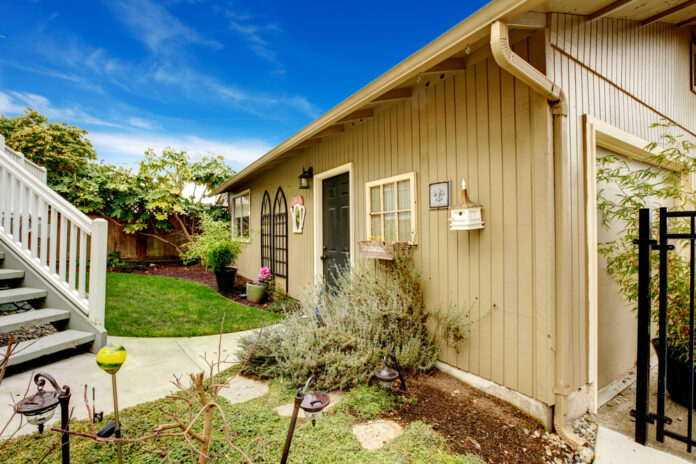Working from home has become more common in recent years, but nothing affected its uptake more than the COVID-19 outbreak. Practically overnight, hundreds of thousands of people had to scramble to set up a workable office space in their homes. If you’re living in a small house, you may not have room. Or with the schools closed, it might be too noisy for you to be able to work with kids running around. If you have space in the garden, you may have a solution.
There are two ways you can approach this. You can either soundproof an existing structure like a large shed or detached garage, or you can build or buy your new office from scratch.
Soundproofing an Existing Structure
1) A room within a room. As sheds are built using wood and garages using bricks, there will be holes and gaps which let sound into your office. If you want complete silence, then the best solution would be to build a room inside your existing structure. This will seal up all the gaps and ensure no sound can enter.
The only drawback is that there may not be enough space to set up your office in a smaller shed, so ensure you measure carefully before you begin.
You’ll need to soundproof all surfaces. For the walls and ceiling, you can use plasterboard or plyboard. You’ll need to add extra mass for the soundproofing to be effective, so here are some options:
- Acoustic plasterboard on the walls (it would likely be too heavy for the ceiling).
- Insulation under the plaster/plyboard. This would also be beneficial for keeping in the heat as sheds and garages aren’t normally heated.
- Mass loaded vinyl fastened to the existing walls and ceiling then boarded in.
- Green glue compound might work, but it’s designed to be used between two sheets of plasterboard.
- Acoustic tape to seal joins.
- Acoustic sealant to seal around windows, light switches and sockets.
You could lay thick carpets or rugs to soundproof the floor, use rubber mats, or put down more mass loaded vinyl. As the flooring will be less permanent than the plasterboard on the walls, you can experiment to see what works.
One of the weakest points in your garage or shed will be the windows and the door. Replace the door with the thickest one possible. If the shed’s frame won’t support a heavy door, then seal up all the gaps around the door with rubber seals and nail quilts or mass loaded vinyl on the back. You could also hang a heavy curtain or blanket over it, which would help keep in the heat.
The window(s) needs to be double glazed and any gaps around them sealed up. You don’t have to add windows if none exist but it could be claustrophobic to be in a room without windows all day, not to mention stuffy.
2) Add mass to the walls. If you don’t have enough space to build a room within a room, then you need to add mass to the walls. More mass = less sound making it into the room. You could use mass loaded vinyl without plasterboarding it as it’s easy to apply and not expensive. You can paint it so that it looks less industrial and more decorative as you’ll be spending a lot of time in your study.
You could also buy acoustic tiles. They will block all sound, but they are pretty expensive and probably more than you’ll need to block out day-to-day noise.
To make these types of soundproofing as effective as possible, you should use a sealant to seal up any gaps in the walls and around the windows and doors before you begin. If you skip this step, you could find that the time and money you invested in soundproofing is jolt as effective as you’d like.
3) Hang moving blankets or soundproof blankets on the walls. Both work reasonably well at blocking sound and can be hung on the walls easily. Soundproof blankets, in particular, come in a range of decorative patterns and with fittings you can use to hang them up. If you’re trying to block road noise or a few stray sounds from your house, then these may be all you need. You’ll also gain the extra benefit of being able to move them into your home if you need temporary soundproofing in there.
Building or Buying a Structure
4) If you’re proficient at DIY, you could build your office yourself. The huge advantage here is you can build the soundproofing into the design. It also means you can decide how best to configure it for your needs. If you’re conscientious when constructing it, you can also minimise any gaps that sound can come through.
To soundproof your building, you can use acoustic plasterboard as well as thick insulation between the inner and outer walls. This will help keep the office warm and block sound. There are also other less traditional options like panels made from hemp, which offer both heat and sound insulation. The inclusion of any soft furnishings like carpets, curtains, and upholstery chairs will block noise even more.
5) Buying the finished item. If you’re short on the time or DIY skills to build an office yourself, some companies do make and deliver garden studios and offices. This is far and away the most expensive option, but only you can balance the cost against how much time you’ll be spending in your office, the loss of time building the office yourself, and how much of your time it will take. If you want something you can just move your furniture into, this is one option.
Conclusion
If you need to work from home and there is nowhere suitable in your house, then converting or creating a room in your garden is a definite option. It may even be better as it creates a degree of separation between your work and home life. If you already have a large shed or garage that you can spare, converting one of them would be the most cost-effective solution.
If you don’t and you do have a large garden, then building a workspace from scratch is possible too. Before beginning, consider your needs, look carefully at all options and make a realistic budget. You can then decide which option is best for you. After that, all that’s left is to build your perfect office and enjoy the peace.
Find a Home-Based Business to Start-Up >>> Hundreds of Business Listings.

















































